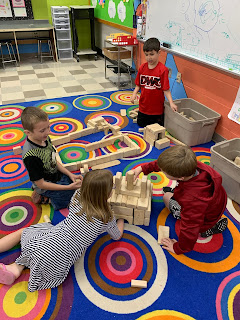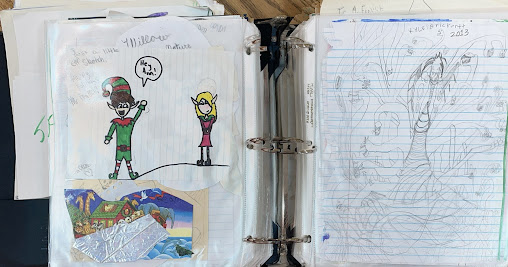What is TAB?
I have been teaching elementary art using the TAB framework for 15 years. Over the path of my learning I have heard a lot of teachers unfamiliar with TAB ask me "What is TAB?" or What is Teaching for Artistic Behavior? That is a very good question. But one that is evidently asked as teachers hear the benefits of TAB. Teaching for Artistic Behavior has been used in some form for many years. Based on constructivist philosophy with a little Reggio Amelia, Montessori and Maker-movement thrown in. Teaching for Artistic behavior has a three sentence curriculum: What do artists do?, The student is the Artist and the room their studio.
In the studio at Sugar Creek, all students are considered artists? What does this mean? It means I leave 99% of all creative decision making up to the students. They choose the subject matter, they chooses the media and they choose how to create it. After I demonstrate how to do something, ie: 5 to 10 minute demo/technique, process or something else. I let the student go into the studio to work. Some will work with the information I shared while others already had an idea before class. Working in an elementary school means, there is a lot of experimenting. If I have any idea what something will look like after a student makes something, I wonder how much influence I had in that process. I steer away from making a project that the kids can follow because they've been trained to parrot instruction. It's not a bad thing in itself, I just don't want my artists doing it in our studio.
 Our studio is the place where we can create. It is a safe place to experiment with ideas, practice making things and messing around with materials. In our studio, students have access to a wide variety of materials to mess around with. Yes messing around. Some might say play. But that's ok, I want my students to have a play mindset. Albert Einstein said "Play is the highest form of research" and he is correct. Who am I to disagree with Albert Einstein? When children play they learn things I can't teach them. They learn what happens when they try new things, how to handle things when ideas don't work, what happens when they play with materials, they are constantly asking "What if" The learn how to see different ways of doing things by working with other artists.
Our studio is the place where we can create. It is a safe place to experiment with ideas, practice making things and messing around with materials. In our studio, students have access to a wide variety of materials to mess around with. Yes messing around. Some might say play. But that's ok, I want my students to have a play mindset. Albert Einstein said "Play is the highest form of research" and he is correct. Who am I to disagree with Albert Einstein? When children play they learn things I can't teach them. They learn what happens when they try new things, how to handle things when ideas don't work, what happens when they play with materials, they are constantly asking "What if" The learn how to see different ways of doing things by working with other artists.
To me play is a state of mind children enter when all barriers are removed. as Mihaly Csikszentmihalyi says they are in a state of flow. When children play, they can enter a hyper-focused state or in a mindset of unending potential. When people say that play isn't really serious learning, I disagree. Have you ever watched children play? There imaginations are on fire! Anything and everything is possible. Solutions to problems disappear and the free flow of thought is amazing. It's what artists do.
What do artists do? is the third part of the TAB curriculum and is spoken more as an answer to many of their questions. When children ask me questions I will respond with "What does an artist do? I don't show them if they can do it themselves. They need to become more reliant on themselves and their intuition than rely on me to give them answers. Student are being trained at an early age to always look for the answers from adults (or Google). It always amazes me when students ask where something is or ask me to do something that they are more than capable of doing. This over reliance
is negatively effecting how are students are learning. It's got to be changing how a child's brain develops. I wonder if this is becoming more of an issue since we went to 1:1 devices. (But this is for another blog post) Students struggle with simple decision making. Most problems are easily solved. As you can see in this video I share with my kids, they get it. They scream at the screen "Just get off" but when it comes to their own problems, they struggle.
TAB is not a curriculum that anybody can pick up and plug into their classroom. It goes much deeper than that. I would ask anyone interested in TAB that they have an honest conversation with themselves about how and what they want to teach children? Twenty years ago, I would never have imagined I would be teaching in this way. But I had, like many other TAB teachers, a moment of cognitive dissonance. A point when I could see as clearly as my hand in front of my face that how I was teaching was polar opposite of what I wanted my students to be learning in my classroom. Once I realized what and why I wanted to change, it was easy. I had a lot of motivation and still do to make my classroom a place where kids can learn to come up with and express their own ideas. I know many teachers who couldn't use TAB because personally could not give up any control in their classroom or trust students to think for themselves. It was a huge shift in how I looked at art education and I thank Katherine Douglas and Diane Jaiquith as well as many others I've met along my journey. The whole TAB community is very open and giving.
In the studio at Sugar Creek, all students are considered artists? What does this mean? It means I leave 99% of all creative decision making up to the students. They choose the subject matter, they chooses the media and they choose how to create it. After I demonstrate how to do something, ie: 5 to 10 minute demo/technique, process or something else. I let the student go into the studio to work. Some will work with the information I shared while others already had an idea before class. Working in an elementary school means, there is a lot of experimenting. If I have any idea what something will look like after a student makes something, I wonder how much influence I had in that process. I steer away from making a project that the kids can follow because they've been trained to parrot instruction. It's not a bad thing in itself, I just don't want my artists doing it in our studio.
 Our studio is the place where we can create. It is a safe place to experiment with ideas, practice making things and messing around with materials. In our studio, students have access to a wide variety of materials to mess around with. Yes messing around. Some might say play. But that's ok, I want my students to have a play mindset. Albert Einstein said "Play is the highest form of research" and he is correct. Who am I to disagree with Albert Einstein? When children play they learn things I can't teach them. They learn what happens when they try new things, how to handle things when ideas don't work, what happens when they play with materials, they are constantly asking "What if" The learn how to see different ways of doing things by working with other artists.
Our studio is the place where we can create. It is a safe place to experiment with ideas, practice making things and messing around with materials. In our studio, students have access to a wide variety of materials to mess around with. Yes messing around. Some might say play. But that's ok, I want my students to have a play mindset. Albert Einstein said "Play is the highest form of research" and he is correct. Who am I to disagree with Albert Einstein? When children play they learn things I can't teach them. They learn what happens when they try new things, how to handle things when ideas don't work, what happens when they play with materials, they are constantly asking "What if" The learn how to see different ways of doing things by working with other artists.To me play is a state of mind children enter when all barriers are removed. as Mihaly Csikszentmihalyi says they are in a state of flow. When children play, they can enter a hyper-focused state or in a mindset of unending potential. When people say that play isn't really serious learning, I disagree. Have you ever watched children play? There imaginations are on fire! Anything and everything is possible. Solutions to problems disappear and the free flow of thought is amazing. It's what artists do.
What do artists do? is the third part of the TAB curriculum and is spoken more as an answer to many of their questions. When children ask me questions I will respond with "What does an artist do? I don't show them if they can do it themselves. They need to become more reliant on themselves and their intuition than rely on me to give them answers. Student are being trained at an early age to always look for the answers from adults (or Google). It always amazes me when students ask where something is or ask me to do something that they are more than capable of doing. This over reliance
is negatively effecting how are students are learning. It's got to be changing how a child's brain develops. I wonder if this is becoming more of an issue since we went to 1:1 devices. (But this is for another blog post) Students struggle with simple decision making. Most problems are easily solved. As you can see in this video I share with my kids, they get it. They scream at the screen "Just get off" but when it comes to their own problems, they struggle.



Comments
Post a Comment